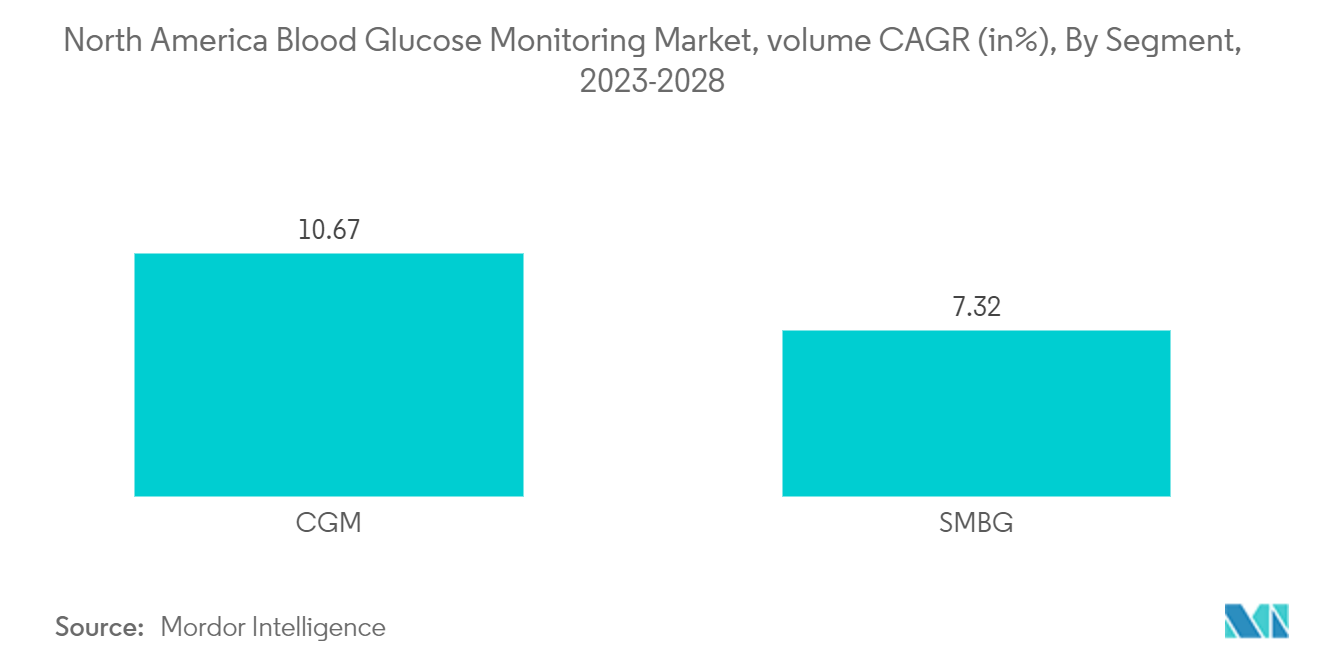Market Trends of North America Blood Glucose Monitoring Industry
Continuous Glucose Monitoring Holds Highest Market Share in the North American Blood Glucose Monitoring Market.
CGMs are used to deliver a more descriptive picture of blood glucose patterns and trends than what may be achieved by traditional routine checking of glucose levels at set intervals. Current CGM devices can either retrospectively display the trends in blood glucose levels by downloading the data or give a real-time picture of glucose levels through receiver displays. Real-time CGMs may alert patients, parents, or caregivers during actual or pending glycemic visits to facilitate the timely management of blood glucose. Due to this factor and the fact that CGM devices are becoming cheaper with the advent of new technologies, like cell phone integration, the CGM market is expected to witness steady growth during the forecast period. Traditional home monitors are not replaced by CGM. To keep the monitor accurate, patients must still check their blood sugar several times per day with a conventional glucose meter. Most monitors still require a finger poke, and every three to seven days, patients should change the sensor placed beneath their skin. Patients who use insulin pumps can connect their CGM system to their insulin pump for continuous monitoring. Patients won't need to manually program the pump, unlike other finger-prick techniques, making it a "sensor-augmented pump."
The use of CGM by Type-1 diabetic patients is much less compared to Type-2 diabetic patients. However, the expenditure incurred by Type-1 diabetic patients on these devices is nearly double that of Type-2 diabetics. The Abbott Freestyle Libre and the Dexcom G6's newest CGM models overcame many technical barriers. However, high costs and uncertainties about their efficacy and necessity kept CGM from being widely used by people with Type-2 diabetes. Moreover, to lower the cost burden of diabetic patients in the United States, Abbott introduced a new, lower-priced category with Libre, at around USD 75 to USD 150 each month (two sensors that last 14 days each). The rise in national awareness of diabetes is anticipated to drive the adoption of SMBGs and CGMs on account of the prognostic and diagnostic treatment of diabetes.

The United States is Expected to Dominate the North American Blood Glucose Monitoring Market.
In the United States, the prevalence of diabetes has increased dramatically in the last two decades, a fact driven by the increased prevalence of obesity and lifestyle changes. Diabetes ranks among the fast-growing chronic diseases in the United States. About 1.75 million US citizens are diagnosed with diabetes every year. The country also has the highest obese population, which is a prominent cause of Type-2 diabetes.
In the United States, innovations by startups like Glooko, OneDrop, Verily, Vacate, Insulet, Noom, Bigfoot Biomedical, Virta Health, Diabeloop, and Orgenesis were launched in the market. The market for diabetes care devices is expected to experience steady growth due to the greater prevalence of obesity, owing to less physical activity, unhealthy food habits, and other lifestyle factors. Abbott and Dexcom received FDA approval to use continuous glucose monitoring in US hospitals for COVID-19-affected people. Dexcom began shipping CGMs to hospitals in April 2020. It aims to make 100,000 sensors for hospitals at low costs. The company plans to donate 10,000 phones and CGM readers to hospitals to scan those sensors.
The growing awareness among people regarding advanced diabetes care products may positively impact the North American diabetes care devices market in the future.


